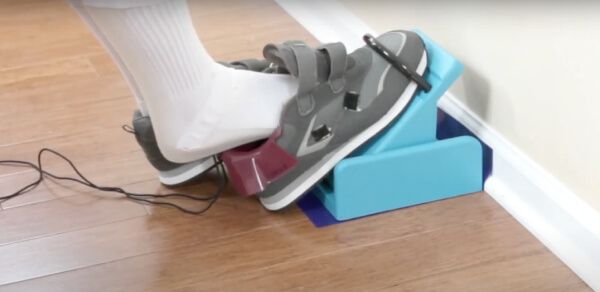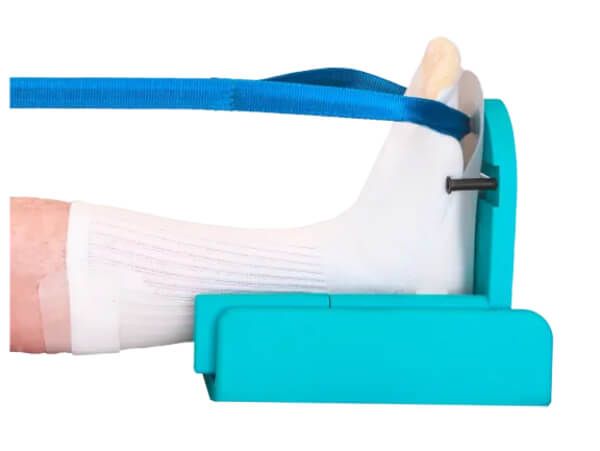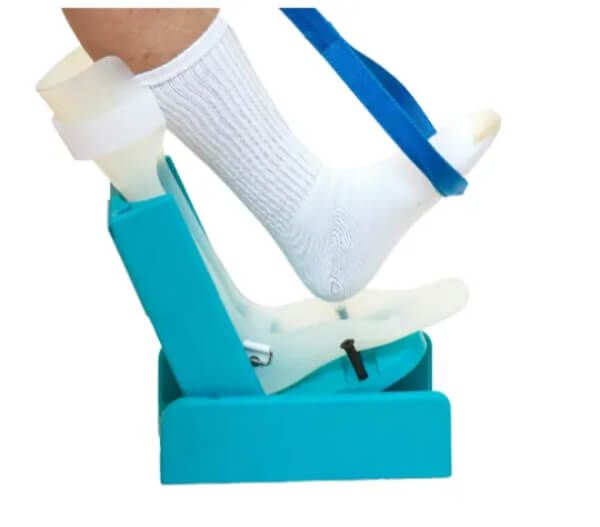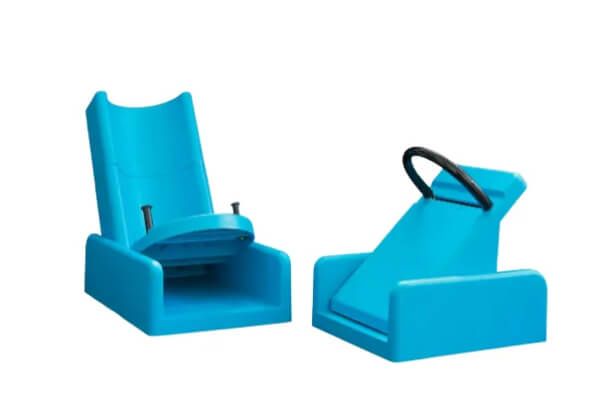 Written by Diane Vitillo, MS, OTR, PTA, CAPS, CLIPP
Written by Diane Vitillo, MS, OTR, PTA, CAPS, CLIPP
 | The Original AFO Assist | AFO Cradle - Made in the USA! View Product |
An ankle foot orthosis (AFO) is a rehabilitation product worn by individuals to correct foot drop and other biomechanical complications caused by a variety of conditions including stroke, cerebral palsy, multiple sclerosis, and other neurological impairments. There are over 7 million stroke survivors living in the United States and two-thirds of them are currently disabled. Countless numbers of stroke survivors wear an AFO.
Many people who need to wear an AFO to safely ambulate often find it difficult to put it on without caregiver assistance. During the AFO donning process, when they place the AFO on the floor, it typically tips over as they try to place their foot into the brace. The Original AFO Assist was created to solve this problem. By placing the AFO in the AFO Cradle, the AFO remains in an upright, stable position and facilitates independent donning. The next step in this task is donning the shoe. But, the ankle is now in a fixed position and can’t easily slide into the shoe when the shoe is placed flat on the floor. The Shoe Platform allows the shoe to be positioned at a 45-degree angle allowing the wearer to extend the knee and slide the foot into the shoe. And, the Foot Funnel (that’s included with The Original AFO Assist) prevents the heel of the shoe from collapsing during donning.
The Original AFO Assist (AFO cradle) securely holds your ankle foot orthosis (AFO) in a stable, upright position preventing it from tipping over during the donning process. Your hands are now free to successfully lift your affected foot into the brace. For clients who only have the use of one arm for putting on their AFO, they can use a leg lifter to easily lift their affected leg and place the foot into the AFO.
The Shoe Platform (which can be adjusted to accommodate a pediatric or adult-sized shoe) holds the shoe at a 45-degree angle to compensate for the fixed position of the ankle in the AFO. When the client is sitting, they can extend the knee and slide the foot into the shoe.
Stroke survivors, especially those who have lost the use of one side of their body (hemiplegia) only have the use of one hand to manage putting on their AFO and shoe. They rely on a product that will hold the AFO “hands-free” so they can use their non-affected arm to lift their affected lower extremity into the AFO and then fasten the ankle strap. The innovative Shoe Platform was purposely designed to place the shoe at a 45-degree angle since the ankle (when in the AFO) is in a fixed position. When the user is sitting, they can extend the knee and slide the foot into the shoe. And, using the Foot Funnel on the heel of the shoe decreases the amount of friction between the shoe and the brace thus preventing the heel of the shoe from collapsing.

Children and adults with Cerebral Palsy often have difficulty with uncontrollable body movements and muscle coordination making it difficult for them to successfully manage holding an AFO in place while trying to lift their foot into the brace. The Original AFO Assist solves this problem by holding the AFO in an upright, stable position allowing them to use their hands to place their foot into the brace. The innovative design of the Shoe Platform allows them to more easily slide into the shoe.
Individuals who need to wear an AFO to safely ambulate don’t always have the luxury of having a family member, friend, or caregiver to help them with this dressing task. They rely on their own strength, coordination, and skill to be able to put on their own ankle brace and shoe. Many cannot return to work or re-engage in their daily routines because they can’t safely walk without wearing their AFO. They increase their risk of falls and serious injury. The Original AFO Assist facilitates independent donning of the AFO and shoe by supporting the AFO and shoe throughout the donning process.
The Original AFO Assist was specifically designed to accommodate AFO donning in either the long- or short-sitting position. Some individuals prefer to put on their brace before they get out of bed in the morning (thus, they use the long-sit position). Others prefer donning the AFO while sitting up in a chair. The Original AFO Assist cradle is easily converted to the preferred position by lifting the cradle portion out of the base and turning it around.

There are many pediatric, young adults, and mature adults who need to wear an AFO to safely walk. The Original AFO Assist is designed to accommodate an AFO and shoe for clients of all ages and most sizes. The Shoe Platform can be easily adapted to hold the toe box of either a pediatric size shoe or an extra wide shoe.

Children who are learning how to dress and put their AFOs and shoes on without parental help will benefit from learning how to use The Original AFO Assist at an early age.
Hemiplegia is the total or partial paralysis of one side of the body that results from disease or injury to the motor centers of the brain. Individuals who only have the use of one hand often find it impossible to hold their AFO securely in an appropriate position for donning while at the same time lifting their affected lower extremity and placing the foot into the brace. The Original AFO Assist solves this problem by holding the AFO in an upright and stable position thus allowing the individual to use their unaffected hand to lift and position their foot in the brace. By placing the Shoe Platform against a wall during the shoe donning process, there is less force required to push the foot into the brace.
The Original AFO Assist wins SILVER in Best in Biz Awards 2018 International; SILVER in The Stevie Awards 2018; and Product Recognition in the Canadian Association of Occupational Therapists 2018. The Original AFO Assist is also featured in the following professional textbooks: “Stroke Rehabilitation/5th Edition” and “Adult Physical Conditions: Intervention strategies for Occupational Therapy Assistants”.

An Occupational Therapist (OT) is a licensed healthcare professional who works with patients from birth to the end of life, and helps them learn techniques and strategies to safely and comfortably perform their everyday activities and re-engage in a life that might have been impacted by disease or injury. The inability to complete a daily task on your own can negatively impact your health and well-being. An OT will help their patient find a way to complete that task … whether it be by adapting an available product or device or inventing one that will solve the problem.
“I’m a 27-year-old disabled individual with Cerebral Palsy and many other conditions affecting my dexterity and coordination. I have progressed a long way with the help of my OT, but one of my biggest and most dreaded tasks was putting on my shoe independently with my AFO because I could never slide my foot into my shoe. Sneakers took me a minimum of 30 minutes to do independently, and by that time I would be ready to break down out of frustration. I recently purchased the AFO assist device and just wanted to personally say THANK YOU so very much!!! This device is going to change my life. Dressing struggles will be gone permanently! The angle on the device is what I needed to solve my problem completely!! Since I am in a wheelchair and live on disability benefits, it took me some time to save up to buy the device, but once I finally did, it was more than worth it!! Thank you so much again! Many blessings to you for creating a product to enrich the lives of folks like myself! I truly appreciate your time, effort, and money spent creating this product! ??”
-Mason M.
“I just wanted to thank you again from the bottom of my heart for spending time with me on the phone and for answering my many questions about The Original AFO Assist. I am so very grateful that I discovered the AFO Assist to use after my knee replacement surgery. Until I discovered your invention online, I was very anxious and had no idea how I was going to put my brace and shoes on and off every day during my recovery. Your invention is brilliant and a lifesaver!”
-Robin B.
“This product, I am certain, will strengthen my daughter’s independence in her ADLs and will also encourage her to wear her AFOs on a consistent basis. Thank you for helping me continue to foster my daughter’s independence as she ages with her disability.”
-Janet B.
A: Yes. Once you’ve placed your foot into the AFO, you need to lift your foot out of the AFO cradle in order to slide it into your shoe. If you don’t have an ankle strap on the AFO, your foot will come out of the brace. However, it is easy to attach your own ankle strap by placing a piece of double stick (hook and loop) Velcro and a Velcro strap on either side of the AFO at the ankle joint position.
A: Just place a piece of non-skid material (like rug gripper material or Dycem) under the AFO Cradle and that will solve the problem!
A: If the tubing is too large, just unscrew the tube from the platform, remove the well nut from the tube and cut the tube to the desired length. Then re-insert the well nut and screw it back onto the platform. If the tubing is too small, just email our company and we’ll send you a longer piece for free.
You’ve learned how important it is to wear your AFO to improve your gait and balance and reduce the risk of falls and injury. Your ultimate goal is to re-engage in your everyday routines and step back into life safely and comfortably. But, you’re frustrated that you’ve been unable to put on your AFO and shoe without someone’s assistance.
The Original AFO Assist was created by an Occupational Therapist to maximize your independence in this dressing task thereby reducing (or even eliminating) the need for caregiver assistance. This USA Made product has solved a long-awaited, major need in the rehabilitation field.

Diane Vitillo, MS, OTR, PTA, CAPS, CLIPP
Diane Vitillo is a Polio survivor who has worked in the field of physical medicine and rehabilitation for over 25 years. Throughout her childhood and adolescent years, she developed many innovative strategies and techniques in order to compensate for the loss of mobility and use of her right shoulder. While working as a healthcare professional with special needs children and stroke survivors, she saw the need to design and manufacture a USA-made product that would facilitate independent donning of an AFO and shoe. The Original AFO Assist is now helping hundreds of people all over the world step back into life.